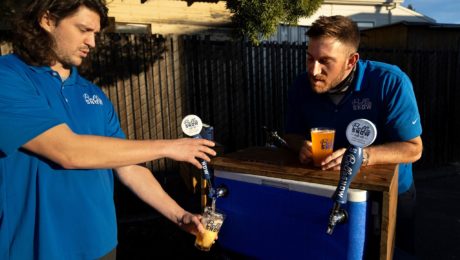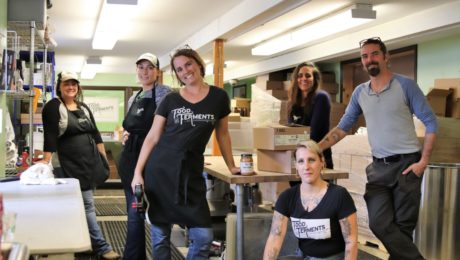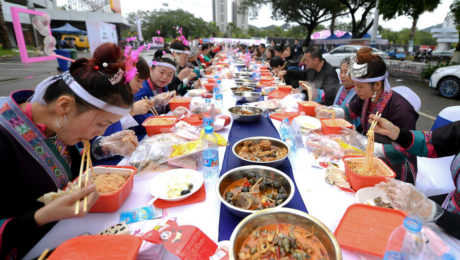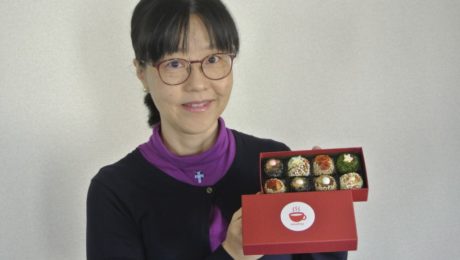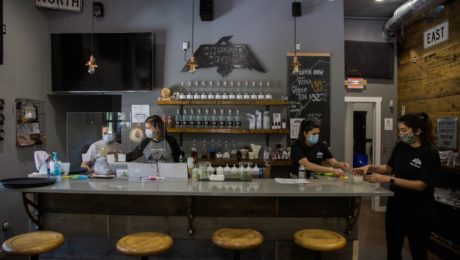From Chemist to Fermenter
Four years ago, Bob Florence, 62, made a radical turn in his decades-long career as an industrial chemist. With the help of his wife Debbi Michiko Florence and business partner James Wayman, he began making small batch soy sauce, miso and other condiments under the brand name Moromi (Japanese for “mash”) Artisanal Shoyu.
Florence always enjoyed cooking, but making soy sauce (shoyu) piqued his interest. “It’s technically really super challenging,” he says. The different types of soybeans, wheat, salt and koji that can be used to create different varieties were especially appealing. Florence trained in Japan with the president of Chiba Shoyu, Kyosuke Iida.
Florence’s partners bring their own skills and perspectives to Moromi. Wayman, a chef at Nana’s Bakery and Pizza and Grass and Bone Butcher Shop in Connecticut, focuses on using local ingredients, some of which he forages. Michiko Florence, a third-generation Japanese American, is a children’s book author who has made food and Japanese culture features of her books.
Read more (The Day)
- Published in Food & Flavor
“More Brew, Less Buzz”
The craft beer industry has been dominated by strong brews or alcohol-free varieties. The New York Times highlights how “craft brewers are increasingly aiming for the sweet spot in the middle.” Low-alcohol beers are growing in popularity, appealing to consumers who want moderation not abstinence.
“There’s just this completely unexplored space,” says Sean Boisson. He started Bella Snow Soft Ale in California, which focuses on ales with no more than 2.4 percent ABV (about half the strength of a traditional beer). Christophe Gagné, owner and brewmaster of Jack’s Abby Craft Lagers in Massachusetts, created a series of low-alcohol beers he calls the 2% Beer Initiative, which has become a bestseller. “I would much rather have two beers and not fall over,” he adds.
The trend is reflecting the preferences of older beer drinkers. Their bodies can’t handle the aftereffects of alcohol and they want to ease back into their IRL responsibilities without a hangover.
“We’re not surprised that lower-ABV. beers are coming of age because, well, millennials are coming of age,” said Lester Jones, the chief economist for the National Beer Wholesalers Association.
Brewers note low-alcohol beer is a challenge. A beer with less alcohol is not easier or even cheaper to produce. Low-ABV beers require less malt (the grains supplying the sugars that are fermented into alcohol) but, if hops are too plentiful, the flavor becomes bitter. And a quality low-alcohol beer also can’t be watery.
Read more (The New York Times)
- Published in Food & Flavor
Covid & the 4k’s: 4 Foods “Many People Don’t Know About”
Renowned professor, epidemiologist and author of The Diet Myth and Spoon Fed Tim Spector is encouraging people to eat the 4k’s: kefir, kombucha, kimchi and kraut. His studies found diet plays a role in preventing severe symptoms of Covid.
Spector is a leading expert on long Covid, the symptoms that can continue for extended periods after an initial infection. He leads the ZOE Covid Study, created by scientists and doctors at King’s College London (where he is based), Stanford, Harvard, Massachusetts General Hospital and health science company ZOE. Last year Spector helped research the attributes and predictors of long Covid, the results of which were published in the journal Nature Medicine.
A microbiome researcher, Spector advocates for people to eat a diverse diet to improve the trillions of microbes in the gut.
“We know from Covid now that your gut health is crucial for your immune system,” he told ITV. “If we can focus on our gut health…gut microbiome is really crucial.”
Diet must be high-quality to improve immunity, he stresses. In the ZOE Covid study, researchers have found eating “the right things and avoiding feeding (the gut) the bad things, that’s what made the difference to getting long Covid,” he said. Fermented foods have proven health benefits, but Spector says many people opt for cheaply-made yogurts and cheeses prevalent in the grocery store to get their daily dose of fermented foods. This dairy is full of sugar and artificial ingredients, which thwart the positive effects of fermentation.
“The other fermented foods that many people don’t know about are what I call the 4 k’s,” Spector says: kefir, kombucha, kimchi and kraut (sauerkraut). He encourages “small shots a day” of a fermented food or beverage. “That really is a powerful enhancer of your microbes. And all these things are going to be cheaper actually than taking multivitamins every day of your life.”
Spector is not a fan of supplements, like pill forms of vitamins and nutrients. Many are proven not to work, he explained. In his studies on the effects of supplements on long Covid, there were minimal benefits for women and none for men.
“People are much better off getting all their vitamins and nutrients by having a diverse diet,” Spector said.
- Published in Food & Flavor, Science
Tastier Apple Spirits
Thanks to their high sugar content and strong flavor, apples have been a great base for spirits like cider, calvados and applejack for hundreds of years. But “many decisions about their processing are still subjectively determined.” When to stop distillation for the most flavorful liquor, for example, is open to question. But new research has identified the best conditions for making apple-based spirits with the most desirable qualities and taste.
Researchers with the American Chemical Society fermented apples into a mash, then distilled it in a German-style batch column. Heat concentrates the alcohol and “removes unpleasant fermentation byproducts, such as carboxylic acids that can impart unclean, rancid, cheesy and sweaty flavors.” The researcher’s mash was continuously monitored during heating, and the levels of the nine carboxylic acids measured.
Heating the mash too quickly yielded unwanted flavor compounds and a bland aroma. But raising the temperature of the cooling tower slightly produced a good fragrance intensity, and reduced carboxylic acid levels.
Read more (American Chemical Society)
- Published in Food & Flavor, Science
World’s Rarest Foods in Danger of Extinction
Journalist Dan Saladino explores the world’s endangered foods in his new book Eating to Extinction: The World’s Rarest Foods and Why We Need to Save Them. He argues that the world could lose culinary diversity. “The story of these foods, and the way in which they’re presented in the book,” says Saladino, from wild foods associated with hunters and gathers, to cereals, vegetables, meats and more, “is really the story of us and our own evolution.”
A review of Saladino’s book in Smithsonian Magazine shares 10 of the world’s rarest foods — five of them fermented. These rarities include:
- Skerpikjøt (Faroe Islands, Denmark): Dried and fermented mutton made from the shanks and legs of sheep. It ferments in wooden sheds called hjallur, which have vertical slats that allow space for the salty sea wind to blow in.
- Salers cheese (Auvergne, France): One of the world’s oldest raw milk cheeses made from the milk of Salers cows. The semi-hard cheese is made with varying fermentation lengths, which change the flavor.
- Qvevri wine (Georgia): Winemakers fill the egg-shaped terracotta pots called qvevri with grape juice, skins and stalks, then bury the pots underground. The steady temperatures and the pot’s shape allows even fermentation.
- Ancient Forest Pu-Erh Tea (Xishuangbanna, China): The fermented tea is made from wild tea leaves that grow in China’s southwestern Yunnan province. The leaves are sun-dried, cooked, kneaded, then formed into solid cakes and fermented for months (or years).
- Criollo Cacao (Cumanacoa, Venezuela): The world’s rarest type of cacao, it represents less than 5% of the cocoa production on the planet. The bean lacks bitterness, but is difficult to grow.
Read more (Smithsonian Magazine)
- Published in Food & Flavor
Beet Kvass: Next Fermented Favorite?
A sign beet kvass is experiencing popularity in America’s artisanal food culture: a beet kvass by New York-based Food & Ferments won a Good Food Award from the Good Food Foundation.
“I kind of describe it as a beet pickle juice,” said Carly Dougherty, co-owner (with her husband Dave) of Food & Ferments. “It’s savory. It’s got ginger and garlic in it as well. It’s not just a beet flavor. It’s really got this, like savory, beet pickle juice kind of vibe to it.”
Kvass originated in Eastern Europe. The Doughertys source their beets locally, which they say makes the beets juicier and better tasting. It ties into their mission to make products “tied to the local landscape that supports farmers.”
This is the second Good Food Award for Food & Ferments. Their first award in 2018 was for their Hearts on Fire Sauerkraut.
Read more (The Ithaca Voice)
- Published in Food & Flavor
“So Stinky, Delicious, Irresistible”
“It’s fermented. It’s stinky. It’s delicious. And during the pandemic, it’s become a national sensation.”
Luosifen — snail noodles — is the subject of NPR’s latest All Things Considered program. The Chinese dish is made with rice noodles soaked in a broth of peeled river snails. It’s then topped with tofu, lemon vinegar and bamboo shoots (which have been covered in salt and fermented for a few weeks).
“Much of the preparation relies on fermentation, common in cuisine from southern Guangxi province where the noodles first began,” the NPR piece continues. “Their malodorous reputation also makes snail noodles quite possibly one of the worst meals to make at home: The smell of the pickled toppings and the stewed snails can linger for hours.”
Social media stars began sharing about the “disgustingly good snack” in 2020 during the Covid-19 pandemic. As a result,over 1.1 billion packets of snail noodle home kits were sold last year. And the city in China where snail noodles originated 25,000 years ago — Liuzhou — is experiencing an economic boom, as the nationwide popularity brings new business to snail noodle food stands, factories and chain restaurants.
Read more (NPR)
- Published in Food & Flavor
Preserving Japan’s Miso Culture
A Japanese public-relations-exec-turned-chef has developed a unique product — Miso Drops, individually-sized servings of stock. She felt it was difficult for an individual customer to use miso from traditional breweries because they only ship products weighing at least 500 grams. Her drops weigh around 26 grams.
Entrepreneur Motomi Takahashi, “alarmed by the gradual disappearance of small-scale miso breweries that have been a key part of Japan’s tradition of fermented foods,” created the soybean paste balls using traditional methods. And, different from the large factories that mass-produce miso products, Takahashi’s miso drops are handmade.
Important to Takahashi is preserving Japan’s rich miso culture. Small-scale miso brewing in the country is “in danger of extinction,” notes an article in Kyodo News. In Japan’s Nagano Prefecture, where most of the miso in the country is made, the number of miso breweries declined 42% from 1963-2010.
Takahashi is developing a product line called misodrop47, which will feature miso drops made in each of Japan’s 47 prefectures. Currently, hermiso drops come from eight.” I wanted to develop products for the misodrop47 project to allow customers to casually sample miso from all over Japan,” she says.
Read more (Kyodo News)
- Published in Business, Food & Flavor
Whey-Based Spirits
Wisconsin-based Native American distillery Copper Crow is using whey to make vodka and gin. Whey (the liquid byproduct of cheesemaking) gives the liquors a creamy, sweet, sake-like taste.Copper Crow one of only a handful of distilleries in the world that makes whey-based spirits.
Whey can be difficult to dispose of. Every pound of cheese leaves behind nine pounds of whey, but it cannot be poured down a drain or into farm fields because it consumes oxygen. Many cheesemakers use it for animal feed or fertilizer.
“The market for the protein-rich, lactose-clouded liquid is minuscule — mostly makers of workout snacks and wellness tonics — but distillers represent a small yet emerging new customer base, with American producers beginning to follow the lead of those in the U.K., France, Australia, and New Zealand,” reads an article on Copper Crow in Fortune.
Copper Crow sits on the Red Cliff Reservation, with Lake Superior artesian aquifers providing pristine water. Owners Curtis and Linda Basina are members of the Red Cliff Band of the Lake Superior Chippewa. Prohibition laws from 1834, though, barred Native Americans from trading alcohol on their reservations.So it would be illegal to run a distillery on their reservation.
The Bassinas found a loophole to the racially-motivated ban — they own title to the land where the distillery is located. Their application was approved, “a watershed moment for Native American entrepreneurs long denied a slice of a booming craft-distilling industry.”
Read more (Fortune)
- Published in Business, Food & Flavor


